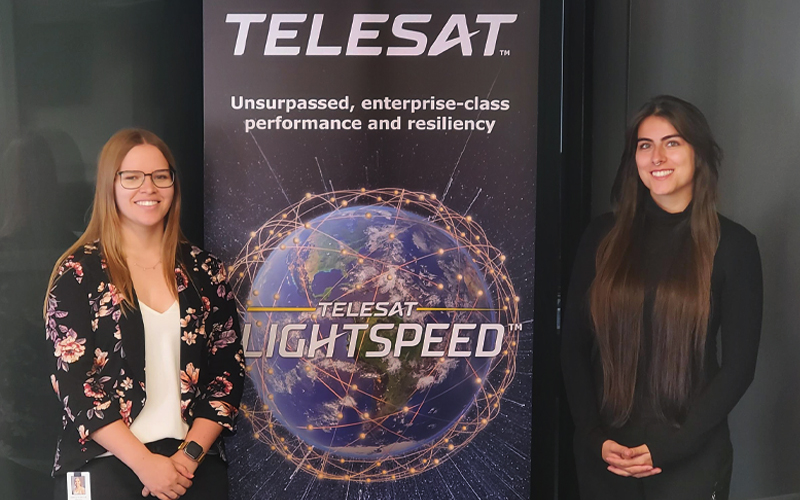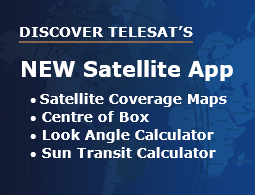Telesat is committed to supporting a diverse workforce and inspiring the next generation of space talent. Last year, we launched a new scholarship program focusing on Indigenous youth in STEM, opening doors for them to explore technology, satellite communications, and satellite and space engineering careers. Two annual scholarships were awarded for students pursuing bachelor’s degrees, a $15,000 stipend and a paid internship at a Telesat office or teleport in Canada.
There are undeniable benefits to having a diverse workforce. Studies have shown that diverse teams outperform homogenous ones, bringing enhanced creativity, problem-solving abilities, and a more inclusive work environment in addition to broader business prospects. Today, less than 2% of Indigenous Canadians work in STEM occupations, and this program was designed to help reduce barriers to education and provide impactful learning and career opportunities in the growing space sector.
Our 2023 Indigenous Fellowship winners are Shaylene Abrey-Webster from Toronto Metropolitan University and Landys Lepine from the University of Alberta. We caught up with them recently to hear about their experiences at Telesat.
The interview below has been edited for clarity and length.
Q: What have been some of the highlights of your internship so far?
LL: I’ve been impressed with Telesat’s consistent support for underrepresented communities aspiring to a space career. Coming from Alberta, the stipend is critical to ensuring that I can genuinely interact with and learn from colleagues. I was able to live in Ottawa and engage with Telesat’s software engineering team in person, in ways that can’t be replicated over a Zoom or Teams call. The networking I’ve been able to do as part of my role has been very rewarding.
SAW: Being an aerospace engineering student, I find this fellowship to be the perfect experience for me. My career focus was previously in aircraft design, however, my experience at Telesat so far has shifted my interests to the space industry. Telesat does a great job of fostering interdependence between each segment of the Telesat Lightspeed development project, for example, through a three-day boot camp session to counter a siloed approach to development.
Q: When did you first discover your interest in STEM?
SAW: My path has always been pretty straightforward. I have a passion for aviation, and I first began flying lessons when I was eight years old. In school, I naturally gravitated to math and science classes.
LL: In high school, I took a heavy dose of biology and chemistry classes. At University, I first majored in psychology science and then became more interested in computer science. Since I didn’t take those classes in high school, I thought I couldn’t enter the field. However, my experience at my university as well as my internship at Telesat has shown me that it’s possible to transition from a broad STEM background into more technical, mathematical work.
Q: What has surprised you about your internship experience at Telesat?
LL: What surprised me was the close-knit sense of community and just how welcoming everyone was at Telesat. Despite being a significant satellite provider, I knew little of the company coming into the program. The company has maintained such a healthy, cooperative culture even as it’s grown.
SAW: I’d second that answer. Everyone here has been so welcoming to interns. I’ve had engineers proactively reach out and offer support and counsel, even on topics unrelated to my specific role. These things tend to come from the top, and I was surprised when, at a team meeting, CEO Dan Goldberg knew the names of all the interns.
Q: Can you briefly describe the main projects you’re working on now?
SAW: I work on the schedule development side, where project management meets engineering. I work on the space team, so I coordinate and reconcile development schedules, for example, from our main contractor, MDA. We’re at the point where we’re finalizing our preliminary design review, so it’s very busy and the schedules are updated every two weeks.
LL: I’m supporting software development for the Constellation Capacity Management System. The software system provides service feasibility request management and capacity analysis for Lightspeed. Specifically, I’m reworking a microservice coded in the Python language and the API that surrounds it. My manager and mentors are supportive and looks for ways I can contribute while also gaining new skills, including projects in programming languages that I will encounter in my future semesters in school.
Q: Has your Fellowship experience increased your likelihood of pursuing a career in space?
LL: Yes, an experience like this definitely opens your mind and shows how flexible a STEM focus can be. Telesat has supplied an intellectually stimulating environment that makes a space career very intriguing.
SAW: Absolutely, yes, though something involving aircraft is still in the running! This has been a wonderful opportunity and I don’t see another way anyone can get such exposure to this exciting field.
Telesat employees are passionately innovating to eliminate the digital divide, improve the reach of 5G networks, and enable data connectivity anywhere. We’re proud to develop technology that improves the lives of Canadians and people all over the world. Through Telesat Lightspeed, one of the world’s most advanced Low Earth Orbit (LEO) satellite constellation networks, Telesat aims to connect rural and remote communities, opening up new opportunities for young Canadians from coast to coast to coast.
A steady stream of fellowship winners like Shaylene and Landys will help provide the human talent and drive necessary to achieve these goals and move Canada forward in space.




